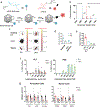Programmable multistage drug delivery to lymph nodes
- PMID: 32523099
- PMCID: PMC7305972
- DOI: 10.1038/s41565-020-0679-4
Programmable multistage drug delivery to lymph nodes
Erratum in
-
Publisher Correction: Programmable multistage drug delivery to lymph nodes.Nat Nanotechnol. 2020 Aug;15(8):724. doi: 10.1038/s41565-020-0748-8. Nat Nanotechnol. 2020. PMID: 32632322
Abstract
Therapeutic delivery selectively to lymph nodes has the potential to address a variety of unmet clinical needs. However, owing to the unique structure of the lymphatics and the size-restrictive nature of the lymph node reticular network, delivering cargo to specific cells in the lymph node cortex and paracortex is difficult. Here, we describe a delivery system to overcome lymphatic and intra-lymph node transport barriers by combining nanoparticles that are rapidly conveyed to draining lymph nodes after administration in peripheral tissues with programmable degradable linkers. This platform enables the controlled release of intra-lymph-mobile small-molecular cargo, which can reach vastly more immune cells throughout the lymph node than either the particles or free compounds alone. The release rate can be programmed, allowing access to different lymph node structures and therefore specific lymphocyte subpopulations. We are thus able to alter the subtypes of drugged lymph node cells to improve immunotherapeutic effects.
Conflict of interest statement
Financial and Non-Financial Competing Interest Statement
The authors declare no conflict of or cometing interest.
Figures









Comment in
-
Targeting immune cells within lymph nodes.Nat Nanotechnol. 2020 Jun;15(6):423-425. doi: 10.1038/s41565-020-0663-z. Nat Nanotechnol. 2020. PMID: 32523098 No abstract available.
References
-
- Kuerer HM et al. Residual metastatic axillary lymph nodes following neoadjuvant chemotherapy predict disease-free survival in patients with locally advanced breast cancer. Am J Surg 176, 502–509 (1998). - PubMed
-
- Lee J-W et al. Peripheral antigen display by lymph node stroma promotes T cell tolerance to intestinal self. Nature Immunology 8, 181 (2006). - PubMed
Publication types
MeSH terms
Substances
Grants and funding
LinkOut - more resources
Full Text Sources

